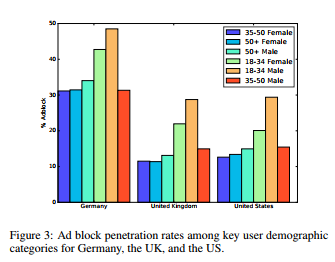
Hot Topics
Digital Advertising – Targetable but do advertisers get what they are paying for?
December 15, 2017
We’re all familiar with the huge year-over-year growth of digital advertising. Way beyond being a shiny new object, advertisers are placing significant portions of their budgets in the digital space. They cite targetability and trackability as major benefits of this medium. And they would be right.
But there are serious downsides with digital advertising.
Ad blocking and ad fraud are two areas of major concern. Ad blocking technology allows users to view content without seeing the advertising that supports that content. Chris Weil, Chairman/CEO of Momentum Worldwide, speaking at the Radio Ink Forecast Conference last month, said only 25%-40% of digital ads are actually reaching consumers and ad blocking grew 40% last year. He also said, “I guarantee you that the last time you clicked on an ad on your phone it was by mistake.”
Ad blocking means that digital advertisers are unable to reach significant portions of a site’s audience. According to a study published jointly by comScore, Inc. and the University of Madison (1), ad blockers are employed by 18% of users in the U.S. The study found that people in the U.S. that employ ad blocking technology are only exposed to about 60% of the ads that non-users see. In other words, the technology is blocking 40% of all ads being served. The study also found that younger visitors and people with the highest incomes are more likely to employ ad blocking technology. This means that impressions will skew to the remaining audience which might not be as desirable to a given advertiser. It also forces up the frequency of the campaign because there are fewer visitors available to be served those impressions. When these ads are not served, the content publishers lose that revenue. It is the equivalent of a large percentage of the passengers on a plane flying for free.
While ad blockers have a significant impact on the revenue of content providers, they do not have as large an impact on the advertisers because if their ad is blocked, they do not pay for that impression. Ad fraud is another story. Ad fraud, also referred to as “Invalid Traffic” or IVT, is broken into two major categories by the Media Ratings Council (MRC). The first is General Invalid Traffic (GIVT) and the other is “Sophisticated Invalid Traffic” (SIVT).
Pixalate published a thorough blog, titled “MRC Definitions for Invalid Traffic: SIVT and GIVT,”(2) that defined each based on the MRC guidelines:
“‘General Invalid Traffic,’ consist[s] of traffic identified through routine means of filtration executed through application of lists or with other standardized parameter checks.”
Examples of GIVT include:
- Known data-center traffic
- Bots and spiders or other crawlers
- Activity-based filtration
- Non-browser user-agent headers or other forms of unknown browsers
- Pre-fetch or browser pre-rendered traffic
SIVT is even more nefarious. Here is the definition of SIVT according to the MRC:
“‘Sophisticated Invalid Traffic,’ consists of more difficult to detect situations that require advanced analytics, multi-point corroboration/coordination, significant human intervention, etc., to analyze and identify.”
Examples of SIVT include:
- Differentiating human and IVT traffic when originating from the same or similar source
- Bots and spiders or other crawlers masquerading as legitimate users
- Hijacked devices, user sessions, ad tags, and ad creative
- Hidden/stacked/covered or otherwise intentionally obfuscated ad serving
- Invalid proxy traffic
- Adware and malware
- Incentivized manipulation of measurements
- Falsified viewable impression decisions
- Falsely represented sites
- Cookie stuffing, recycling, or harvesting
- Manipulation or falsification of location data
Regardless of what you call it, IVT is costing advertisers billions of dollars each year. According
to the ad verification company Adloox (3), ad fraud will cost advertisers $16.4 billion globally in 2017. They also claim that nearly 20 percent of total digital ad spend was wasted in 2016.
According to The&Partnership’s research, online advertising campaigns bought using automated/programmatic technology have a much higher risk of ad fraud. They claim that $7.8 billion (29%) of the $27 billion spent on programmatic advertising globally in 2016 was on IVT, while $4.65 billion (12%) of online ads bought directly from publishers were ad fraud.
The largest advertisers have taken notice of these issues. They use “viewability” as a metric to measure whether an ad has been seen, or clicked on, by a real human. In January 2017, at the Internet Advertising Bureau’s (IAB) Annual Leadership meeting, Procter and Gamble’s chief marketing officer Marc Pritchard called for reform of the media supply chain that places online ads: “We serve ads to consumers through a non-transparent media supply chain with spotty compliance to common standards, unreliable measurement, hidden rebates and new inventions like bot and methbot fraud.”
Every media needs to be accountable to its advertisers. Where there are large amounts of money to be made, there are certain to be attempts to manipulate the system. Digital content providers and advertising platforms such as Google and Facebook are in the process of trying to counter these attempts by unscrupulous players to skew the system. Only then will they regain the confidence of large advertisers such as Proctor and Gamble.
1: Ad Blockers: Global Prevalence and Impact (http://pages.cs.wisc.edu/~pb/imc16a_final.pdf)
2: http://blog.pixalate.com/mrc-definitions-sivt-givt-invalid-traffic-detection-filtration
3: https://www.cnbc.com/2017/03/15/businesses-could-lose-164-billion-to-online-advert-fraud-in-2017.html
-Marc Greenspan, Partner

Comments